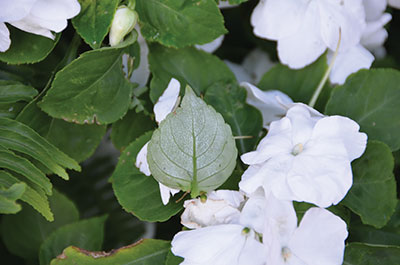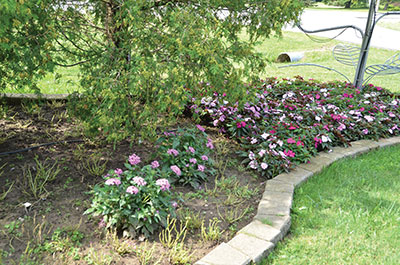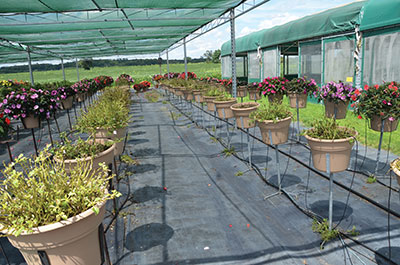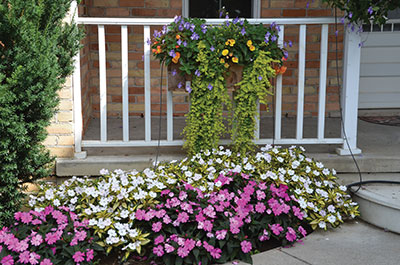
Features
Crop Culture
Inputs
Growing in the Green: Re-inventing a star performer
September 23, 2013 By Melhem Sawaya
The impatiens walleriana genus was the greatest success story of the floriculture industry.
The impatiens walleriana genus was the greatest success story of the floriculture industry. Impatiens emerged as a new and promising crop in the late 1970s. Breeding efforts intensified and the race to capitalize on this crop took the efforts of many breeders.
 |
|
| Downy mildew spores on the underside of a leaf. Advertisement
|
In the 1980s, the new cultivars brought considerable gardening success with impatiens. This continued for the next 20 years. While there has been some levelling off in sales, it remains extremely popular.
A few years ago, breeders began repackaging impatiens with more consistent flowering times, growth regulator pretreated seeds, and colour mixes under a trade name.
Breeders and marketers, it seemed to me, were running out of ideas to get an even larger piece of the market. However, that did not matter: total usage remained strong because consumers were still enjoying considerable success.
Around 2005, however, there were reports of downy mildew fungus in England and various parts of Europe. But it was far from home and we did not worry about it. In fact, we ignored it totally. No one wanted to kill the goose that was laying the golden eggs, despite suspecting the fungus could soon spread.
THE DISEASE
■ Downy mildew produces whitish masses of sporangiophores or conidiophores on the under-surface of the leaves of the host, and unfortunately impatiens walleriana is a most welcoming host.
 |
|
| Infected impatiens walleriana plants next to healthy Divine New Guinea impatiens.
|
The problem was noticed in a couple of Ontario greenhouse operations about four years ago. However, it was felt it would never spread quickly in landscapes.
Two years ago, growers started treating plants against downy mildew. There was no sign of it in greenhouses where impatiens walleriana was grown. These treatments were very effective to the point growers were thinking that if the product was clean in the greenhouse, there should be no problems in the garden.
Unfortunately, this was not the case. There were problems in many landscapes.
This past spring, despite production cuts, there were still a good number of impatiens grown. Landscapers may have stopped using them, but many homeowners continued to take them home, probably believing they would avoid problems.
I have looked through many gardens that are planted with impatiens, and I can safely say they were all infected with downy mildew. The level of infection varied from just a few spores on bottom leaves to total leaf drop.
The level of infections variation could depend on a variety of factors:
Type of fungicide used. Some fungicides are more effective than others.
Timing. How recently was the fungicide applied? Fungicides are only effective for a certain period of time.
Dr. Aaron Palmateer is at the University of Florida. He evaluated several rotations of very effective downy mildew fungicides during the production phase of impatiens crops.
He then evaluated the effect of treating the landscape ground beds before planting with Subdue granules. He applied different rotations of fungicides. The best control was from Subdue Maxx, which kept the impatiens plants clean for eight weeks.
If an Ontario grower applied Subdue Maxx on plants that were later planted in gardens on May 24, then all the plants would be dead by July 24. And who knows how soon downy mildew will be resistant to the available treatments.
Planting date. The earlier the crop is planted, the earlier it will show symptoms that will be more severe. Early season conditions tend to be wetter, and more time has passed since the fungicide was applied.
Pot size. The larger the pot size the plants were transplanted from, the later the mildew will show.
Type of irrigation. Sprinklers and overhead irrigation can speed the infection and spread the fungus. This doesn’t mean that drip irrigation or sub-irrigation will solve the problem, but the symptoms will show up later.
Planting location. The dryer the location, the later the symptoms will develop. In full sun, the leaves do not get wet and mildew will not develop until the optimum conditions prevail (moist, cool, cloudy, etc.).
Blowing in the wind? Downy mildew spores travel for long distances, spreading infection along the way.
Resilient spores. If impatiens plants are placed in a flowerbed that was infected with downy mildew the year before, the new crop will not have a chance because downy mildew spores overwinter in our Canadian conditions for more than one season.
I planted treated impatiens plants in our garden this year. By July 10, the plants started to defoliate. The plants irrigated through our drip system did not last that much longer and they defoliated completely.
THE CAUSE
■ Nobody knows why this is happening, or more likely, nobody wants to admit why it is happening.
 |
|
| Infected impatiens walleriana plants in container trials.
|
We know it is not that the disease developed an immunity to chemical controls. It could simply be that the genus walleriana is especially susceptible to the disease.
The number 1 factor for susceptibility is inbreeding. I have been watching impatiens cultivars since the early 1980s, and the different cultivars soon began to look like each other. Every breeder was developing compact, early flowering plants to jam in very small cell packs.
I am not a genetics expert, but any inbreeding for the same characteristics from within the same gene pool is doomed to breed a very weak link. In my view, the weak link in impatiens walleriana is its susceptibility to downy mildew!
THE SOLUTION
■ The only solution is to stop growing impatiens walleriana until breeders establish varieties that are resistant to downy mildew. By doing so, the spores will die over time. There will be fewer spores being spread around if we eliminate the host.
 |
|
| Sunpatiens are a healthy alternative and excellent garden performers.
|
If the breeders do not take this initiative, then growers should not grow them. But if growers don’t stop growing impatiens, then retail buyers should not sell any impatiens until a solution is found.
GREAT OPPORTUNITY
■ What a great opportunity for growers and their retail customers to grow alternatives to impatiens! They should explain why they don’t carry impatiens, while at the same time promoting alternatives that could be more rewarding.
The most important thing is that you are not knowingly growing or selling plants that have a much reduced chance of success for consumers. High failure rates by gardeners will affect your reputation and your business.
THE ALTERNATIVES
■ Here are some alternative crops. I am sure every breeder and supplier has some additional suggestions.
- Begonia, including fibrous, tuberous and boliviensis, and every one of these groups has many cultivars.
- Coleus has a variety of colourful foliage plants, both seed and vegetative.
- Sunpatiens impatiens is an excellent alternative for sun and shade use. Each plant will cover the same area that 14 plants of the regular walleriana impatiens would cover, so it is very cost effective.
- New Guinea impatiens, both seed and vegetative.
I will further discuss the alternatives in a future issue.
THE WINNERS
■ Winners are those individuals or companies that can take a problem and turn it into an opportunity. “We cannot control the wind,” someone once said, “but we can always adjust the sail.”
THE LESSON
■ There is an end to everything. If we are not willing to adjust quickly and take steps to look and plan for the next thing, we will be going backward. Learn how to adjust your sails with every change in wind direction. To do that, you cannot have a boat full of holes.
Melhem Sawaya of Focus Greenhouse Management is a consultant and research coordinator to the horticultural industry. Comments on this or any other article are always welcome at mel@focusgreenhousemanagement, or by visiting www.focusgreenhousemanagement.com or www.sawayagardentrials.ca .
Print this page